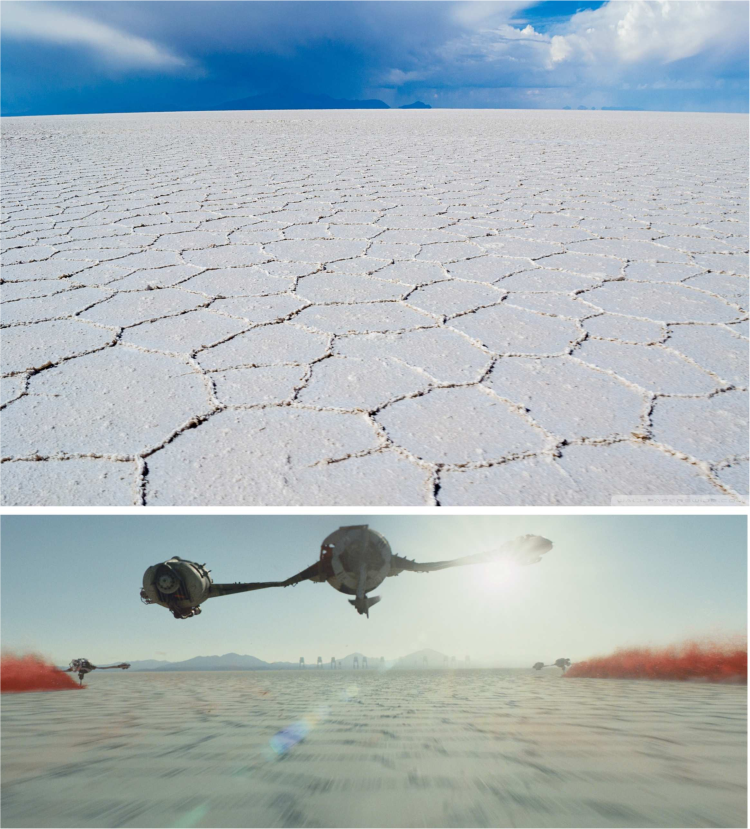Emergence of polygons on dry salt lakes
Dry salt lakes are scenic parts of desert landscapes which can be found all around the world, from Sua Pan in Botswana to Salar de Uyuni in Bolivia (cf. Figure 1 top panel) and the lakes of Death Valley in the USA. They are recognised as geological marvels: Badwater Basin, in Death Valley, receives over a million visitors per year and some of the most iconic scenes of Star Wars The Last Jedi were filmed at Salar de Uyuni (cf. Figure 1 bottom panel).

Dry salt lakes form in arid valleys where groundwater or rivers flow in, but not out. Owing to the extreme conditions that often prevail in such places, evaporation may deplete lakes, leading to locales that appear dry but where the water table is not far below the surface. This results in dry salt lakes. The porous soil below the water table contains dissolved minerals that are transported upward by the evaporation flow. As water evaporates, it leaves behind these minerals which form a rigid salt crust at the visible surface of the lake. These crusts often form wondrous patterns constituted of raised ridges that reach up to 10cm and that form polygons spanning 1m to 2m horizontally. Human activity can also lead to the formation of dry salt lakes. For example, Owens Lake was a naturally sustained lake until the Owens river was diverted into the Los Angeles aqueduct in 1913, leading to the progressive desiccation of the lake.
When wind blows, the lake crust erodes and the resulting salty dust gets transported away. Depending on its composition, this dust can constitute an important external source of nutrients to ecosystems like oceans. However, not all dust is beneficial. The dust produced by Owens Lake contains toxic substances like arsenic and has been recognised as a major health hazard to the neighbouring populations, leading to an ongoing onerous remediation effort involving continuous monitoring and dust prevention techniques such as shallow flooding, managed vegetation and gravel covering.
We are interested in the polygonal patterns that appear on the surface of dry salt lakes for two reasons. The first one is curiosity: these patterns produce magnificent landscapes but their formation is not understood. Obtaining an in-depth knowledge of this natural phenomenon has obvious scientific value. Further, the presence of raised ridges on the salt crust impacts dust production; understanding their formation will enable the design of better management techniques.
In recent work, we identified that the fluid dynamics taking place below the visible surface of the lake plays an important role in the formation of crust polygons. The model we studied is phenomenologically simple, yet confers intricate dynamics that resemble field observations (https://www.youtube.com/watch?v=0qM9UQpbrGY). The lake is a porous medium (soil) containing salty water. It is driven by evaporation, which drives the flow upward, and by the salty crust, which locally increases the salinity of the fluid and, thus, makes it denser. This model correctly predicts the surface pattern wavelength and is in qualitative agreement with field observation regarding the geometry of the patterns produced. This work received media attention internationally (Nature Physics, Physik Journal, Pour la Science, …) and has become part of the International Physicists’
Tournament (https://iptnet.info/problems/).
Despite the above successful predictions, our model is still too simplistic to study dust control production. In particular, experimental evidence shows that the crust thickness impacts the local evaporation rate, which we currently do not take into account. In this thesis, we will study the impact of a spatially but also temporally variable crust thickness, and its implication on the local evaporation rate, on the formation of crust patterns and on the accumulation of salt in the crust. This work will have a strong modelling and numerical component (see: http://www.cbeaume.com/en/codes.html) and will be supported by Leeds High-Performance Computing Facilities (https://arc.leeds.ac.uk/index.html).
References
Christiansen, Science 139, 607–609 (1963)
Li & Shi, Vadose Zone J. 20, e20122 (2021)
Lasser, Salt polygons and porous media convection, https://www.youtube.com/watch?v=vNJk6AdsOoI (2021)
Lasser, Nield & Goehring, Earth Syst. Sci. Data 12, 2881–2898 (2020)
Lasser et al., Phys. Rev. X 13, 011025 (2023)
Nield, Bryant, Wiggs, King, Thomas, Eckhardt & Washington, Geology 43, 31–34 (2015)
Wooding, Water Resour. Res. 33, 1199–1217 (1997)
